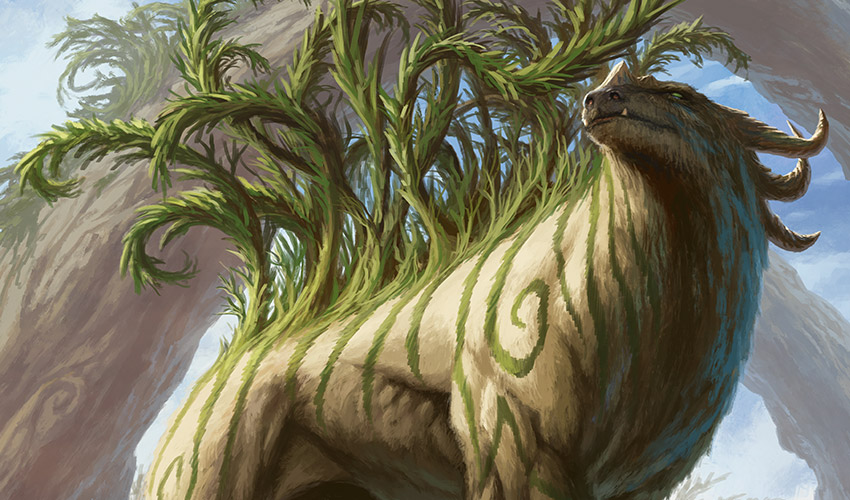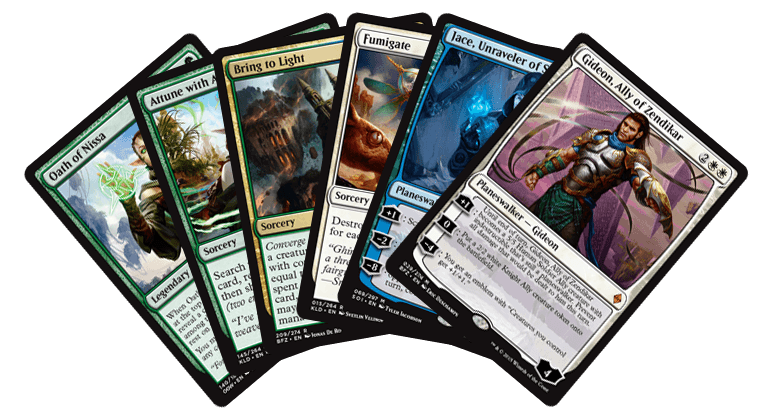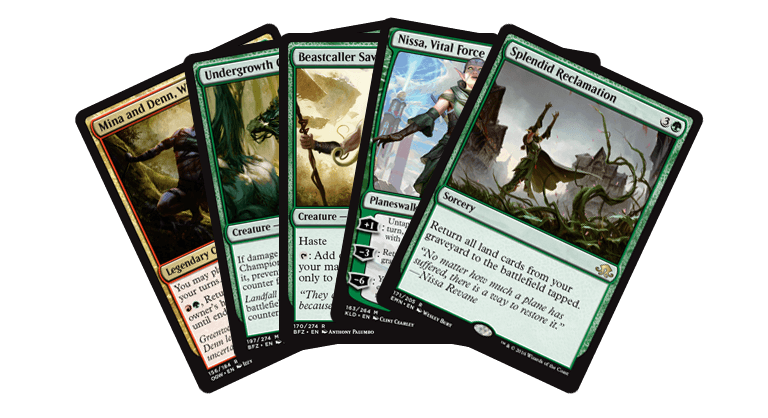How to Build with Green
Forests of towering trees, crumbling ruins covered in flowering vines, Squirrels leaping from branch to branch, hulking Beasts wandering grassy fields—green revels in nature in all its forms.

Green loves both individual, board-dominating creatures and swarms of smaller ones. It cultivates resources, most often mana, and then uses those resources to create more and more threats. Green represents a dichotomy of being both gentle in its care for the natural world and fierce in its defense of it. It excels at dealing with anything intrusive to the natural world, including enchantments and artifacts, but its affinity for creatures means that it can also have a difficult time killing those on the other side of the battlefield.

Let's take a look at what, in particular, green excels at in the current Standard format:
- Green is aggressively producing and using Kaladesh's trademark resource—energy! If you're looking to generate a lot of energy quickly, green is the color to turn to.
- One of the ways to use that energy is to branch out from green and produce mana of any color. Cards like Attune with Aether and Servant of the Conduit are turning Standard's new resource to old purposes like ramping or fixing mana.
- Green is as good as ever at summoning mana-efficient creatures like Sylvan Advocate and Bristling Hydra, and it loves making those creatures even bigger! Cards like Tireless Tracker, Verdurous Gearhulk, and Cultivator of Blades give themselves or their battlefield companions bonuses as games develop.
- This Standard season, green is also more well-equipped than usual to search for a deck's most potent monsters. Cards like Eldritch Evolution and Traverse the Ulvenwald act as tutors for whatever creature a given deck or situation calls for.
Top Cards
Green decks have been dominating the standings of Standard events around the world since the introduction of Kaladesh. Below are some of green's top cards making waves in competitive Standard. Understanding these cards and why they're good can help you utilize green better in your Standard brews.
This legendary Spider, along with her horde of tiny Spider friends, has been a staple of Black-Green Delirium decks since Pro Tour Kaladesh. Ishkanah can stabilize a board that looked completely hopeless a turn or two before and is a way to win the game once you've locked up the battlefield. Ishkanah dodges some of white-blue's powerful cards, like Spell Queller or Reflector Mage, and not much can attack through her. One of Ishkanah's more subtle strengths is that she works so well in conjunction with the other cards you naturally want in a delirium-based deck. If Traverse the Ulvenwald can fetch Ishkanah, that means delirium is already turned on and she'll arrive on the battlefield with her brood in tow. Cards like Grapple with the Past; Liliana, the Last Hope; and Vessel of Nascency dig for Ishkanah and help fill the graveyard, making it more likely that you'll have delirium by the time you're ready to cast her.
Speaking of, Traverse the Ulvenwald is another key player in Standard, functioning as both a way to fix mana and to tutor up creatures. It's a card that's great to cast both early in the game, when it makes sure that you hit the types of lands you need when you need them, and in the late game, when it's effectively another copy of the most powerful or flexible creatures in your deck. It's not going to live in a deck that can't hit delirium, but with Evolving Wilds and a few key artifacts running around Standard along with the usual mix of instants, sorceries, planeswalkers, and more, delirium is not difficult to achieve.
This common from Kaladesh has been a surprisingly strong role player this Standard season. It's a key piece of Aetherworks Marvel decks, as playing an Attune in an early turn of the game significantly increases your chances of having the required six energy to activate the artifact the turn it comes into play. It's also found a home in Bristling Hydra decks, where the sorcery provides food for the four-mana creature.
Like Attune with Aether, this common has proven invaluable in Aetherworks Marvel and other energy-centric strategies. Like Attune, Servant of the Conduit's ability to fix mana in a multi-color deck is secondary to the two energy counters that it brings with it. Servant of the Conduit is another key piece in Aetherworks decks, and an ideal opening for that deck involves a turn-one Attune followed by a turn-two Servant.
Tireless Tracker is an old friend from the previous Standard season, but it's still a key piece in a handful of green-based decks. It's not necessarily a four-of, but Black-Green Delirium players have been tuning the number of Trackers in their main decks and sideboards to try to gain an edge in key matchups. Tireless Tracker is both a threat and a way for green decks to generate card advantage, as holding a Tracker until you can play a land will guarantee at least one Clue, and an unanswered Tracker can generate an overwhelming number of Clues over the course of a game.
Other cards seeing play in Standard, though not necessarily as frequently as those above, include Verdurous Gearhulk (played in some aggressive black-green and red-green decks), Sylvan Advocate (a choice for some black-green decks), Bristling Hydra (which has its own energy-based aggro deck), and Nissa, Vital Force (also seen in some red-green decks).
Cards to Try
These cards don't have a solid home in Standard...yet! They do, however, have unique and untapped potential, and are worth trying if you're looking to explore uncharted territory.
This mythic rare from Battle for Zendikar has the potential to take over a game if left unchecked. It dodges damage-based removal like Harnessed Lightning and Radiant Flames. It can also go toe-to-toe with much of Standard's current suite of creatures and live to tell the tale, given a few turns (or a single Evolving Wilds). I can imagine a turn-two Servant of the Conduit into a turn-three Undergrowth Champion and a follow-up land providing a powerful start for an aggressive deck looking for creatures with relevance in the late game. If it found a home in a landfall-centric deck, Undergrowth Champion could live up to its name and become the star of an aggressive green deck.
That leads me to my next card, Mina and Denn, Wildborn. While the 4/4 body for four mana is solid, it's the text on this Oath of the Gatewatch legendary creature that really leaves room for invention. With Splendid Reclamation also available in Standard, there's room to go deep on this strategy and try to put together an aggressive landfall-based deck. Mina and Denn also give aggressive decks a way to push damage through when an opponent has landed an Ishkanah with delirium, as it takes away the option of simply chump blocking with a Spider token to buy time.
Speaking of pushing through damage, Cultivator of Blades is another card that, though expensive at five mana, has a lot of potential. There are still a handful of creatures from the Battle for Zendikar block that come with Eldrazi Scions and other fabricate cards from Kaladesh that create multiple creatures. A deck featuring Cultivator of Blades could go big on top of already going wide, maximizing the number of creatures in play by the time Cultivator of Blades hits the table and following up with a lethal alpha strike.
Switching gears, Eldritch Evolution is another as-yet-underutilized Standard card. In Eldritch Moon Standard, emerge decks took advantage of cheap utility creatures like Pilgrim's Eye to power out giant Eldrazi monsters. Eldritch Evolution takes the same general idea in a different direction. There are still utility creatures like Pilgrim's Eye and new addition Filigree Familiar (which has the added benefit of drawing a card when it dies) ready to be sacrificed in pursuit of a bigger, better replacement. This deck could also make new use of perennial Standard player Seasons Past because, while Eldritch Evolution exiles itself, the sacrificed creatures go to the graveyard. If Liliana has taught me anything, it's that the graveyard is not where creatures go to rest peacefully.
It's time to admit something I've been hiding (at least in this one particular article)—I love control, and this card is a bit of a pet inclusion for me. Maybe it's just a crazy dream, but when I see Arborback Stomper, I see a card that could make a green-based control deck work. Okay, maybe it's midrange. Maybe it goes with Eldritch Evolution and the two three-mana utility creatures outlined above. Gaining 5 life is a lot, and a 5/4 body with trample deals huge chunks of damage if it's not dealt with. Sacrificing three-drops with two different card types to summon five-drops might also work well with a certain Spider already dominating Standard, so maybe it's not just a crazy dream after all.
Deck Concepts
Below are just two loosely sketched deck ideas to use as a jumping off point or to inspire you if you're still unsure of where to start in dreaming up
Five-Color Bring to Light Control

This deck takes the mana fixing available in the current Standard format and stretches it to the absolute limit. Because the deck's power would likely come from a suite of planeswalkers, Oath of Nissa becomes another piece of fixing, allowing you to cast any of your choice of Standard's current superfriends. While Bring to Light can't fetch planeswalkers, it could get spells designed to help you survive—like Arborback Stomper to gain life and apply pressure to an opposing 'walker or Fumigate to gain life and wipe the board. Servant of the Conduit might have another home in this deck, as it both ramps to your expensive spells and fixes your colors.
Red-Green Landfall

This deck would expand on the landfall theme I mentioned above when talking about Undergrowth Champion and Mina and Denn, Wildborn. It could bend toward aggressive, playing cards like Scythe Leopard and Snapping Gnarlid to maximize damage when Mina and Denn come down and allow for double landfall triggers. If the deck opted to play Evolving Wilds, it could create three or four landfall triggers in a single turn! Cards like Nissa, Vital Force and Splendid Reclamation could help give the deck power through after turn five, while Beastcaller Savant or Servant of the Conduit could power out threats more quickly while saving land drops for critical turns where they buff up creatures and push through damage.
These are just a few cards and a handful of strategies that green can work with in the current Standard format. If nothing here quite suits what you're hoping to do, check out the other articles on building in each of the four other colors. No matter what deck you decide to build, good luck and have fun!

